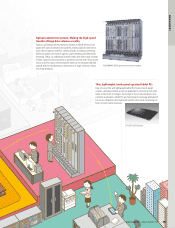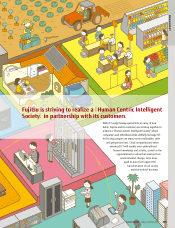Fujitsu 2011 Annual Report Download - page 18
Download and view the complete annual report
Please find page 18 of the 2011 Fujitsu annual report below. You can navigate through the pages in the report by either clicking on the pages listed below, or by using the keyword search tool below to find specific information within the annual report.
A review of fiscal 2010
Impact of earthquake and response
QUESTION. 1
This was your first year as president after being appointed in April 2010. Please tell us what
fiscal 2010 meant for you and for the Company.
ANSWER. 1
Fiscal 2010 was a year in which we solidified our business foundation in preparation for the
next stage of sustained growth. Damage caused by the earthquake made the business envi-
ronment extremely challenging, but the Fujitsu Group forged ahead unrelentingly with struc-
tural reforms and investments into new business areas.
In my first year, my highest personal priority was to strengthen the business foundation for sustained growth. That
was precisely what we did in fiscal 2010.
As for the overall market environment, my impression was that the pace of economic recovery in fiscal 2010 was
slower than originally forecast. When I was appointed president in April 2010, we expected the economy to recover to
a level prior to that of the global financial crisis. Interest in ICT investment among companies, however, was weaker
than anticipated. Then, the Great East Japan Earthquake in March 2011 further undercut recovery expectations. But
even in this severe business environment, we did not let up with structural reforms and new business investments.
For example, in the area of strengthening the Group business structure, in October 2010 we completed the
mobile phone business merger with Toshiba Corporation to establish Fujitsu Toshiba Mobile Communications
Limited. Other key initiatives included the restructuring of our network products manufacturing divisions, and the
establishment of a core company to serve the medium-size business market in Japan.
In terms of investment in platforms for business growth, we invested aggressively into the development of new
products and technologies for the future. We made steady progress, for example, on the development of datacen-
ters to provide a global public cloud service in six key markets: Japan, Australia, Singapore, the US, the UK, and
Germany. We also initiated the shipment of a next-generation supercomputer system* to Japan’s Institute of Physi-
cal and Chemical Research (RIKEN).
Our proposals in new business areas also met with success. For example, we entered a joint services venture
with US-based aircraft manufacturer Boeing using RFID tags to streamline aircraft maintenance. In the US, we
conducted joint field trials with energy company Kit Carson Electric Cooperative on a remote metering system.
These are just a few of the many new ICT services we are developing.
I’m satisfied that we moved with speed
and agility in fiscal 2010 to continue our
structural reforms and make new invest-
ments in businesses that will sustain our
future growth. On the other hand, I regret
that, due to the deterioration of the market
environment, we were unable to meet all
of our financial targets and the expecta-
tions of investors.
QUESTION. 2
Please explain the extent of the damage from the Great East Japan Earthquake, the impact
on your financial results, and your recovery measures.
ANSWER. 2
Some of our plants and a part of our supply chain in the Tohoku region of northern Japan
sustained damage from the earthquake, but we succeeded in restoring operations to normal
capacity quickly through an all-out recovery effort. Fujitsu continues to support rebuilding in
the disaster-stricken areas with ICT*1 services and other aid.
We designed our datacenters with thorough anti-earthquake measures. As a result, our Tatebayashi System Center in
Gunma Prefecture, which is not far from the epicenter of the earthquake, suffered no major damage, and our cus-
tomers’ data and assets were secure. We also continued to provide datacenter services during the rolling blackouts
* The next-generation
supercomputer was ranked
No. 1 on the TOP500
Supercomputer list. See “The
Story Behind the Shipment
of the Next-Generation
Supercomputer System” on
p. 061 for more details.
*1 ICT
Information and communication
technology, a term derived from
IT (information technology) and
communication, which includes
the sharing of knowledge and
information via communication
networks.
Financial Highlights (Billions of yen)
(Years ended March 31) 2009 2010 2011
Net sales 4,692.9 4,679.5 4,528.4
Operating income 68.7 94.3 132.5
Net income (loss) (112.3) 93.0 55.0
Interest-bearing loans 883.4 577.4 470.8
Net D/E ratio (times) 0.47 0.20 0.14
016 FUJITSU LIMITED ANNUAL REPORT 2011
A CONVERSATION WITH THE PRESIDENT
























